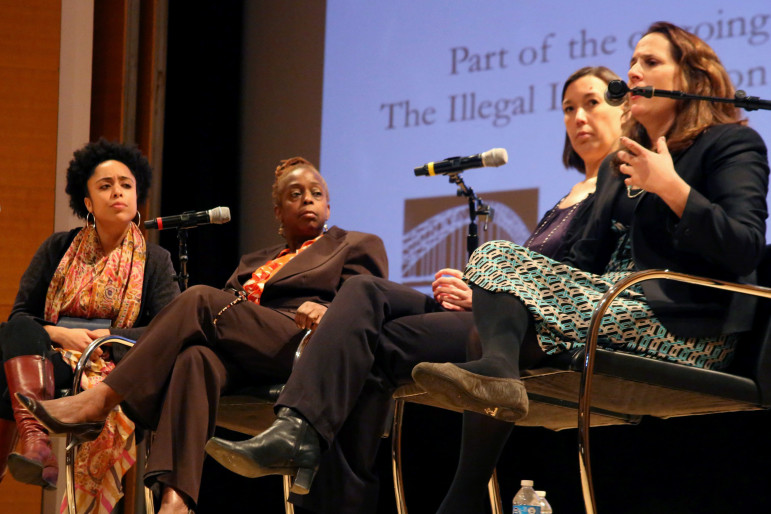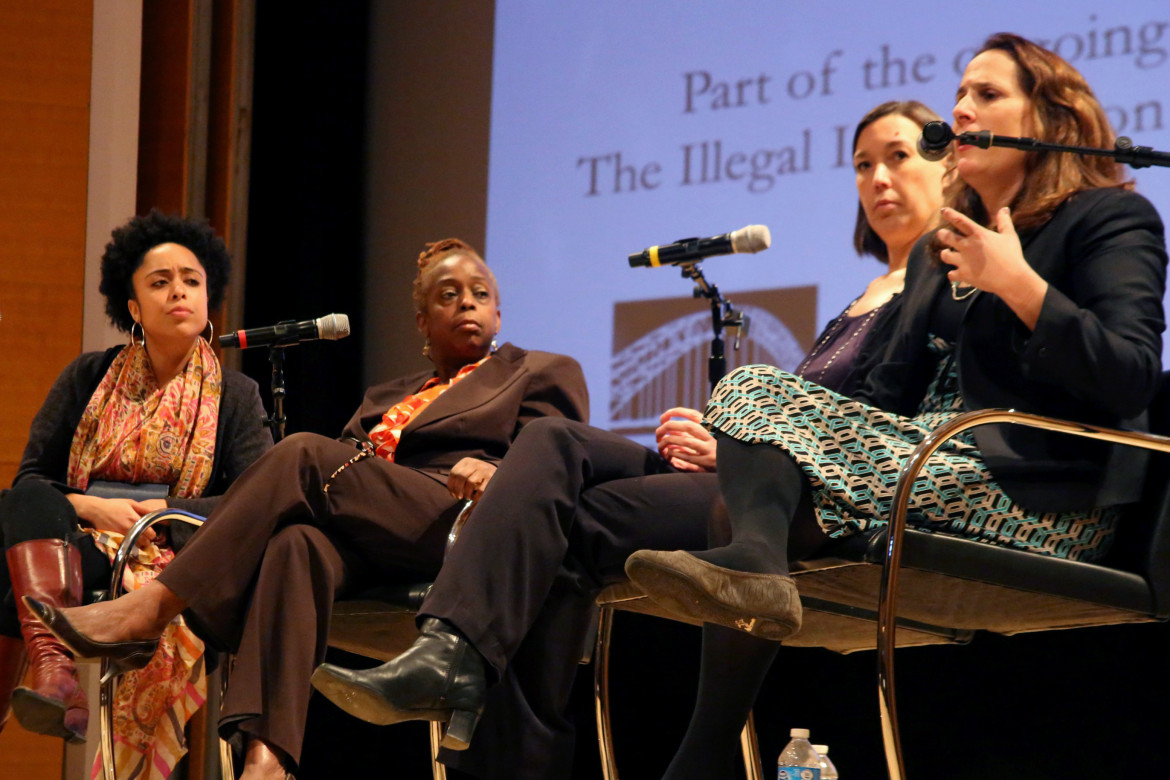
Meral Agish
From left, Tynesha McHarris, director of community leadership at the Brooklyn Community Foundation, Renee Gregory, first assistant district attorney in the Brooklyn District Attorney's office, and Krista Larson, director of the Vera Institute of Justice’s Center for Youth Justice, and Nell Bernstein, author of Burning Down the House.
NEW YORK — When Nell Bernstein, the editor of a youth newspaper, looked at her staff, she saw bright young people at work. But in those years, the 1990s, some looked at those same faces and saw little more than a threat — and began to react with force.
Based on little other than appearance, these young people became victims of the “superpredator” theory. Bernstein described that as “a mythical creature with a hoodie and a black face, with no conscience, no spirit, no soul, who we were asked to believe lived in the bodies of our teenagers."
 Her staff members started getting arrested on their way to work. The arrests got so frequent that some quit, saving themselves from exposure to further targeting.
Her staff members started getting arrested on their way to work. The arrests got so frequent that some quit, saving themselves from exposure to further targeting.
For Bernstein, seeing her young colleagues unfairly profiled in this way led her to act. In the decades since, juvenile justice reform has become a core theme in her investigative reporting.
“I was seeing these beautiful spirits maligned and misrepresented. And I was seeing this horrific treatment go unquestioned,” she said. “I thought if I could tell it, people would be horrified and want to change.”
Bernstein’s most recent book, “Burning Down the House: The End of Juvenile Prison,” was the inspiration for “Burning Down the House: Rebuilding Juvenile Justice Together,” a group discussion that brought six people involved in juvenile justice work to the Brooklyn Museum.
The conversation touched on what is being done, and what still needs to be done, to reform an incarceration model that all six participants — and many in the audience, based on supportive snaps and applause — agreed was no longer an option.
The conversation also included an element that is sometimes missing from discussions about juvenile justice reform: a young person’s voice. Abdul Francis, 17, of Brooklyn shared his own expertise, gained through personal experience with incarceration.
Francis said youths like him, who have been through the system, need to be part of the conversation because they fully know its trauma. “It’s good to talk to them because they know the pain they’re feeling,” he said.
He has been talking to young people in his community and advising them to look beyond what may seem like limited options. “I know how to relate to kids,” he said. “I tell everybody, get out of the game, go back to school, do what you gotta do.”
The experts discussed reform efforts now in progress in New York state, including the Vera Institute of Justice’s youth justice policy initiatives, the Brooklyn District Attorney’s youth diversion programs and the Brooklyn Community Foundation’s youth justice philanthropy work.
Talk topics included shifting cultural and personal views of young people, especially young people of color, who are disproportionately represented in the justice system.
Just as the “superpredator” label had unfairly distorted perceptions of her young newspaper staff, Bernstein said, youth incarceration as a whole is “a system custom-designed to erode humanity.”
“Once you put someone in an orange jumpsuit and put a label like ‘offender’ or ‘delinquent’ on him or her, it’s very easy to start thinking of that person as a different kind of child,” she said.
After the discussion, the audience walked on stage to have books signed by Bernstein and chat with other guests.
Jasmine Bowie, a youth justice social worker at the Brownsville Community Justice Center and one of the participants, looked on as Francis was interviewed on camera and posed for photographs. She has been Francis’s social worker since he was released from nonsecure placement last year.
Bowie, who estimated she keeps in touch with 40 to 50 youths while managing an active caseload of 20 clients, said youth justice programs like hers “can really aid in the process of changing the narrative for these young people, to keep them from being reduced to their crimes.”
While social workers, lawyers and public policy experts will keep steering reform in the right direction, she said, young people need to be just as engaged.
“Young people need to become aware of these different systems and the big fight that we’re up against,” she said. “I try to get the young people to understand that they can be social change agents. They have to lead the way.”
The event was hosted by the Brooklyn Museum’s Elizabeth A. Sackler Center for Feminist Art as part of a series called “States of Denial: The Illegal Incarceration of Women, Children, and People of Color.”
In her welcome remarks, Dr. Elizabeth A. Sackler, the museum’s chairwoman, said the series “will be ongoing until we no longer need it.” The next two events, scheduled for later this month, will focus on the role of women in justice reform and personal stories of incarceration.
